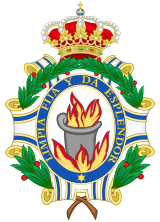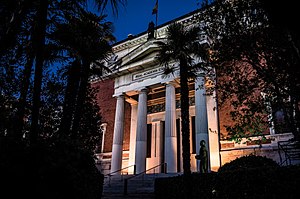The Royal Spanish Academy (Spanish: Real Academia Española, generally abbreviated as RAE) is Spain's official royal institution with a mission to ensure the stability of the Spanish language. It is based in Madrid, Spain, and is affiliated with national language academies in 22 other Hispanophone nations through the Association of Academies of the Spanish Language.[1]
Real Academia Española | |
 Arms of the Royal Spanish Academy | |
| Abbreviation | RAE |
|---|---|
| Formation | 1713 |
| Founder | The Duke of Escalona |
| Purpose | Linguistic prescription and research |
| Headquarters | Madrid, Spain |
Region served | Hispanophone regions and populations |
Official language | Spanish |
Director | Santiago Muñoz Machado |
Main organ | Junta de Gobierno |
| Affiliations | Association of Spanish Language Academies |
| Website | www |
The RAE dedicates itself to language planning by applying linguistic prescription aimed at promoting linguistic unity within and between various territories, to ensure a common standard. The proposed language guidelines are shown in a number of works.
Motto
In the awareness, according to the vision of the time that the Spanish language had reached a moment of utmost perfection, the purpose of the Royal Academy was "to establish the voices and words of the Castilian language in their greatest propriety, elegance and purity." . This purpose was represented with an emblem formed by a fiery crucible placed on the fire, with the legend Limpia, fija y da esplendor ("It purifies, it fixes, and it dignifies").[2] Therefore, the institution was born as an effective work center, as the founders said, "at the service of the honor of the nation."
This vocation for collective utility became the main hallmark of the Spanish Academy, differentiating itself from other academies that had proliferated in the golden centuries and that were conceived as mere occasional literary gatherings.
History



The Royal Spanish Academy was founded in 1713, modeled after the Accademia della Crusca (1582), of Italy, and the Académie Française (1635), of France, with the purpose "to fix the voices and vocabularies of the Spanish language with propriety, elegance, and purity". King Philip V approved its constitution on 3 October 1714, placing it under the Crown's protection.[citation needed]
Its aristocratic founder, Juan Manuel Fernández Pacheco, Duke of Escalona and Marquess of Villena, described its aims as "to assure that Spanish speakers will always be able to read Cervantes" – by exercising a progressive up-to-date maintenance of the formal language.[citation needed]
The RAE began establishing rules for the orthography of Spanish beginning in 1741 with the first edition of the Ortographía (spelled Ortografía from the second edition onwards). The proposals of the Academy became the official norm in Spain by royal decree in 1844, and they were also gradually adopted by the Spanish-speaking countries in the Americas.Several reforms were introduced in the Nuevas Normas de Prosodia y Ortografía (1959, New Norms of Prosody and Orthography). Since the establishment of the Association of Academies of the Spanish Language in 1951, the Spanish academy works in close consultation with the other Spanish language academies in its various works and projects. The 1999 Orthography was the first to be edited by the twenty two academies together.[3] The current rules and practical recommendations on spelling are presented in the latest edition of the Ortografía (2010).
The headquarters, opened in 1894, is located at Calle Felipe IV, 4, in the ward of Jerónimos, next to the Museo del Prado. The Center for the Studies of the Royal Spanish Academy, opened in 2007, is located at Calle Serrano 187–189.
Fundamentals
According to Salvador Gutiérrez, an academic numerary of the institution, the Academy does not dictate the rules but studies the language, collects information and presents it. The rules of the language are simply the continued use of expressions, some of which are collected by the Academy. Although he also says that it is important to read and write correctly.[4] Article 1 of the statutes of the Royal Spanish Academy, translated from Spanish, says the following:[5]
The Academy is an institution with legal personality whose main mission is to ensure that the changes experienced by the Spanish language in its constant adaptation to the needs of its speakers do not break the essential unity it maintains throughout the Hispanic world. It must equally ensure that this evolution preserves the characteristic nature of the language, as gradually consolidated over the centuries, as well as establishing and disseminating the criteria for its proper and correct use, and contributing to its splendor.
To achieve these ends, it shall study and promote the study of the history and present of Spanish, it shall disseminate the writings, literary—especially classics—and non-literary, that it deems important for the knowledge of such matters, and will seek to keep alive the memory of those who, in Spain or in the Americas, have cultivated our language with glory.
As a member of the Association of Academies of the Spanish Language, it shall maintain a special relation with the corresponding and associated academies.
Composition

Members of the Academy are known as Académicos de número (English: Academic Numerary), chosen from among prestigious people within the arts and sciences, including several Spanish-language authors, known as The Immortals (Spanish: Los Inmortales), similarly to their French Academy counterparts. The numeraries (Spanish: Números) are elected for life by the other academicians. Each academician holds a seat labeled with a letter from the Spanish alphabet, with upper and lower case letters denoting separate seats.

The Academy has included Latin American members from the time of Rafael María Baralt, although some Spanish-speaking countries have their own academies of the language.
Current members

Notable past academicians
- Niceto Alcalá-Zamora
- Vicente Aleixandre
- Dámaso Alonso
- José "Azorín" Martínez Ruiz
- Vicente Bacallar y Sanna
- Pío Baroja
- Jacinto Benavente
- Carlos Bousoño
- Manuel Bretón de los Herreros
- Camilo José Cela
- Miguel Delibes
- José Echegaray
- Fernando Fernán Gómez
- Wenceslao Fernández Flórez
- Gaspar Melchor de Jovellanos
- Alicia Jurado
- Antonio Machado
- Salvador de Madariaga
- Julián Marías
- Francisco Martínez de la Rosa
- Ramón Menéndez Pidal
- Armando Palacio Valdés
- José María de Pereda
- Benito Pérez Galdós
- Manuel José Quintana
- Gonzalo Torrente Ballester
- Leonardo Torres Quevedo
- Juan Valera
- José Zorrilla
Publications
- Joint publications of the RAE and the Association of Academies of the Spanish Language
- Diccionario de la lengua española (Spanish Language Dictionary). The 1st edition was published in 1780, and the 23rd edition in 2014.[6] It can be consulted for free online as of October 2017[7] and was published in Spain and other Spanish-speaking countries to mark the tricentennial of the founding of the RAE.[citation needed]
- The Diccionario esencial de la lengua española (Essential Dictionary of the Spanish Language) was published in 2006 as a compendium of the 22nd edition of the Dictionary of the Spanish Language.[8]
- Ortografía de la lengua española (Spanish Language Orthography). The 1st edition was published in 1741 and the latest edition in 2010. The edition of 1999 was the first spelling book to cover the whole Hispanic world, replacing the Nuevas normas de prosodia y ortografía (New Rules for Prosody and Spelling) of 1959.[citation needed]
- Nueva gramática de la lengua española (New Spanish Language Grammar, 1st edition: 1771, latest edition: 2009).[9][10] The latest edition is the first grammar to cover the whole Hispanic world, replacing the prior Gramática de la lengua española (Grammar of the Spanish Language, 1931) and the Esbozo de una Nueva gramática de la lengua española (Outline of a New Grammar of the Spanish Language, 1973). The Nueva gramática de la lengua española is available in 3 different versions: The Edición completa (Complete Edition) includes 3,800 pages in two volumes to describe morphology and syntax (published December 4, 2009) plus a third volume of phonetics and phonology and a DVD (early 2010).[citation needed]
- The Manual edition is a single 750-page volume, which was presented at the 5th Congress of the Spanish Language which convened virtually in Valparaíso, Chile, due to the earthquake, and was released on April 23, 2010.[11]
- The Gramática básica (Basic Grammar) is a 305-page volume directed to people who received secondary education, and which can be adaptable for school use; it was first published in 2011.[12][13][14]
- The RAE has also published two other works by individual editors: Gramática de la lengua española (Grammar of the Spanish Language, by Emilio Alarcos Llorach, 1994) and Gramática descriptiva de la lengua española (Descriptive Grammar of the Spanish Language, 3 volumes, directed by Ignacio Bosque and Violeta Demonte, 1999).[citation needed]
- Diccionario panhispánico de dudas (Pan-Hispanic Dictionary of Doubts, 1st edition: 2005). Resolves doubts related to the use of the Spanish language. Can be consulted online since 2006.[15]
- Diccionario del estudiante (Student's Dictionary, 1st edition: 2005). Directed to students in secondary education between 12 and 18 years-old.[16]
- Diccionario práctico del estudiante (Student's Practical Dictionary, 1st edition: 2007) is an adapted version for Latin America of the Student's Dictionary.[17]
- Diccionario de americanismos (Dictionary of Americanisms) is a listing of Spanish language terms of the Americas and their meaning. First edition published in 2010.[18]
See also
References
External links

- Official website
 (in Spanish)
(in Spanish)

